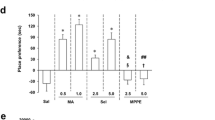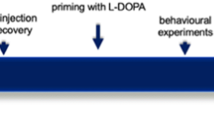Abstract
EGb761 produces reversible inhibition of both monoamine oxidase (MAO) isoforms in the central nervous system. 1-methyl-4-phenylpyridinium (MPP+) neurotoxicity is prevented by treatment with the MAO inhibitor pargyline. We investigated EGb761's effect on striatal MAO activity during MPP+ neurotoxicity. C-57 black mice were pretreated with EGb761 (10 mg/kg) daily for 17 days followed by administration of MPP (0.72 mg/kg). MPP+ enhanced striatal MAO (30%) activity at 6 h, and EGb761 prevented this effect. MAO-B activity in striatum was enhanced (70%) 6 h after MPP+ administration and was reduced to almost normal levels in EGb761 + MPP+ group compared to MPP+ group. Pretreatment with EGb761 partially prevented (32%) the striatal dopamine-depleting effect of MPP+ and prevented the reduction in striatal tyrosine hydroxylase activity (100%). Results suggest that EGb761 supplements may be effective in reducing MAO activity as well as enhancement in dopamine metabolism, thereby preventing MPP+-neurotoxicity.
Similar content being viewed by others
references
Jenner, P. 1989. Clues to the mechanism underlying dopamine cell death in Parkinson's disease. J. Neurol. Neurosurg. Psychiatry (special suppl):22–28.
Fahn, S. and Cohen, G. 1992. The oxidant stress hypothesis in Parkinson's disease: Evidence supporting it. Ann. Neurol. 32:804–812.
Glover, V., Sandler, M., Owen, F., and Riley, G. 1977. Dopamine is a monoamine oxidase B substrate in man. Nature 265:80–81.
Cohen, G. 1986. Monoamine oxidase, hydrogen peroxide, and Parkinson's disease. Pages 119–125, in Yahr, M. D. and Bergmann, K. J., (eds.), Advances in Neurology: Parkinson's disease, vol. 45, Raven Press, New York.
Riederer, P. and Jellinger, K. 1983. Neurochemical insights into monoamine oxidase inhibitors, with special reference to deprenyl (selegiline). Acta Neurol. Scand. Suppl. 95:43–55.
Knoll, J. 1995. Rationale for (−) deprenyl (selegiline) medication in Parkinson's disease and in prevention of age-related nigral changes. Biomed. Pharmacother. 49:187–195.
Gerlach, M., Riederer, P., Przuntek, H., and Youdim, M. B. H. 1991. MPTP mechanisms of neurotoxicity and their implications for Parkinson's disease. Eur. J. Pharmacol. Mol. Pharmacol. 208:273–286.
Zang, L. Y. and Misra, H. P. 1993. Generation of reactive oxygen species during the monoamine oxidase-catalyzed oxidation of the neurotoxicant, 1-methyl-4-phenyl-1,2,3,6-tetrahydropyridine. J. Biol. Chem. 268:16504–16512.
Javitch, J. A., D'Amato, R. J., Strittmatter, S. M., and Snyder, S. H. 1985. Parkinsonism-inducing neurotoxin, N-methyl-4-phenyl-1,2,3, 6-tetrahydropyridine: Uptake of the metabolite N-methyl-4-phenylpyridine by dopamine neurons explains selective toxicity. Proc. Natl. Acad. Sci. USA 82:2173–2177.
Nicklas, W. J., Vyas, I., and Heikkila, R. E. 1985. Inhibition of NADH-linked oxidation in brain mitochondria by 1-methyl-4-phenylpyridinium, a metabolite of the neurotoxin 1-methyl-4-phenyl-1, 2, 3, 6-tetrahydropyridine. Life Sci. 36:2503–2508.
Chan, P., DeLanney, L. E., Irwin, I., Langston, J. W., and DiMonte, D. 1991. Rapid ATP loss caused by 1-methyl-4-phenyl-1, 2, 3, 6-tetrahydropyridine in mouse. J. Neurochem. 57:348–351.
Adams, J. D., Klaidman, L. K., and Leung, A. 1993. MPP+ and MPDP+ induced oxygen radical formation with mitochondrial enzymes. Free Radic. Biol. Med. 15:181–186.
Adams, J. D. and Odunze, I. N. 1991. Biochemical mechanisms of 1-methyl-4-phenyl-1, 2, 3, 6-tetrahydropyridine toxicity. Biochem. Pharmacol. 41:1099–1105.
Wu, R. M., Mohannakumar, K. P., Murphy, D. L., and Chiueh, C. C. 1994. Antioxidant mechanism and protection of nigral neurons against MPP+ toxicity by deprenyl (selegiline). Ann. NY Acad. Sci. 738:214–221.
Sagi, Y., Weinstock, M., and Youdim, M. B. 2003. Attenuation of MPTP-induced dopaminergic neurotoxicity by TV3326, a cholinesterase-monoamine oxidase inhibitor. J. Neurochem. 86(2):290–297.
DeFeudis, F. V. 1998. Ginkgo biloba extract (EGb761): from chemistry to the clinic. Ullstein Medical, Wiesbaden, P. 401.
Marcocci, L., Packer, L., Droy-Lefaix, M., Sekaki, A., and Gardes-Albert, M. 1994. Antioxidant action of Ginkgo biloba extract EGb761. Methods Enzymol. 234:462–475.
Pardon, M. C, Joubert, C., Perez-Diaz, F., Christen, Y., Launay, J. M., and Cohen-Salmon, C. 2000. In regulation of cerebral monoamine oxidase activity in senescent controls and chronically stressed mice by long-term treatment with Ginkgo biloba extract (EGb 761). Mech. Ageing Dev. 113:157–168.
Ramassamy, C., Clostre, F., Christen, Y., and Costentin, J. 1990. Prevention by a Ginkgo biloba extract (GBE 761) of the dopaminergic neurotoxicity of MPTP. J. Pharm. Pharmacol. 42:785–789.
Rojas, P., Garduño, B., Rojas, C., Vigueras, R. M., Rojas-Castañeda J, Ríos, C., and Serrano Garcia, N. 2001. EGb761 blocks MPP+-induced lipid peroxidation in mouse corpus striatum. Neurochem. Res. 26(11):1245–1251.
Wu, W-R. and Zhu, X-Z. 1999. Involvement of monoamine oxidase inhibition in neuroprotective and restorative effects of Ginkgo biloba extract against MPTP-induced nigrostriatal dopaminergic toxicity in C-57 mice. Life Sci. 65(2):157–164.
Rojas, P. and Ríos, C. 1993. Increased striatal lipid peroxidation after intracerebroventricular MPP+ administration to mice. Pharmacol. Toxicol. 72:364–368.
Morinan, A. and Garrat, H. M. 1985. An improved fluorometric assay for brain monamine oxidase. J. Pharmacol. Methods 13(3):213–223.
Kehr, W., Carlsson, A., Lindquist, M., Magnusson, T., and Atack, C. 1972. Evidence for a receptor mediated feedback control of striatal tyrosine hydroxylase activity. J. Pharm. Pharmacol. 24:744–747.
Miquel, J. and Fleming, J. 1986. Theoretical and experimental support for an “oxygen radical mitochondrial injury” hypothesis of cell aging. Pages 51–74, in Johnson, Jr., Walford, R., Harman, D., and Miquel, J. (eds.), Free radicals, aging and degenerative diseases, vol. 8, Alan R. Liss, Inc., New York.
Richter, C., Park, J. W., and Ames, B. 1988. Normal oxidative damage to mitochondrial and nuclear DNA is extensive. Proc. Natl. Acad. Sci. USA. 85:6465–6467.
Johns, D. R. 1995. Mitochondrial DNA and disease. N. Engl. J. Med. 333:638–644.
Hauptmann, N., Grimsby, J., Shih, J. C., and Cadenas, E. 1996. The metabolism of tyramine by monoamine oxidase A/B causes oxidative damage to mitochondrial DNA. Arch. Biochem. Biophys. 335(2):295–304.
Sastre, J., Millán, A., De la Asunción García, J., Plá R., Juan, G., Pallardó, F. V., O'Connor, E., Martín, J. A., Droy Lefaix, M. T., and Viña, J. 1998. A Ginkgo biloba extract (EGb761) prevents mitochondrial aging by protecting against oxidative stress. Free Radic. Biol. Med. 24(2):298–304.
Corbisier, P., Raes, M., Michiels, C., Pigeolet, E., Houbion, A., Delaive, E., and Remacle, J. 1990. Respiratory activity of isolated rat liver mitochondria following in vitro exposure to oxygen species: A threshold study. Mech. Ageing Dev. 51:249–263.
Scalettar, B. A., Abney, J. R., and Hackenbrock, C. R. 1991. Dynamics, structure and function are coupled in the mitochondrial matrix. Proc. Natl. Acad. Sci. USA. 88:8057–8061.
Mitra, N., Mohanakumar, K. P., and Ganguly, D. K. 1994. Resistance of golden hamster to 1-methyl-4-phenyl-1, 2, 3, 6-tetrahydropyridine: Relationship with low levels of regional monoamine oxidase B. J. Neurochem. 62:1906–1912.
Melega, W. P., Cho, A. K., Schmitz, D., Kuczenski, R., and Segal, D. S. 1999. L-amphetaminepharmacokinetics and pharmacodynamics for assessment of in vivo deprenyl-derived L-amphetamine. J. Pharmacol. Exp. Ther. 288:752–758.
Sloley, B. D., Urichuk, L. J., Morley, P., Durkin, J., Shan, J. J., Pang, P. K. T., and Coutts, R. T. 2000. Identification of karempferol as a monoamine oxidase inhibitor and potential neuroprotectant in extracts of Ginkgo biloba leaves. J. Pharm. Pharmacol. 52:451–459.
Ara, J., Przedborski, S., Naini, A. B., Jackson-Lewis, V., Trifiletti, R. R., Horwitz, J., and Ischiropoules, H. 1998. Inactivation of tyrosine hydroxylase by nitration following exposure to peroxynitrite and 1-methyl-4-phenyl-1,2,3,6-tetrahydropyridine (MPTP). Proc. Natl. Acad. Sci. USA 95:7659–63.
Author information
Authors and Affiliations
Corresponding author
Rights and permissions
About this article
Cite this article
Rojas, P., Rojas, C., Ebadi, M. et al. EGb761 Pretreatment Reduces Monoamine Oxidase Activity in Mouse Corpus Striatum During 1-Methyl-4-Phenylpyridinium Neurotoxicity. Neurochem Res 29, 1417–1423 (2004). https://doi.org/10.1023/B:NERE.0000026406.64547.93
Issue Date:
DOI: https://doi.org/10.1023/B:NERE.0000026406.64547.93




